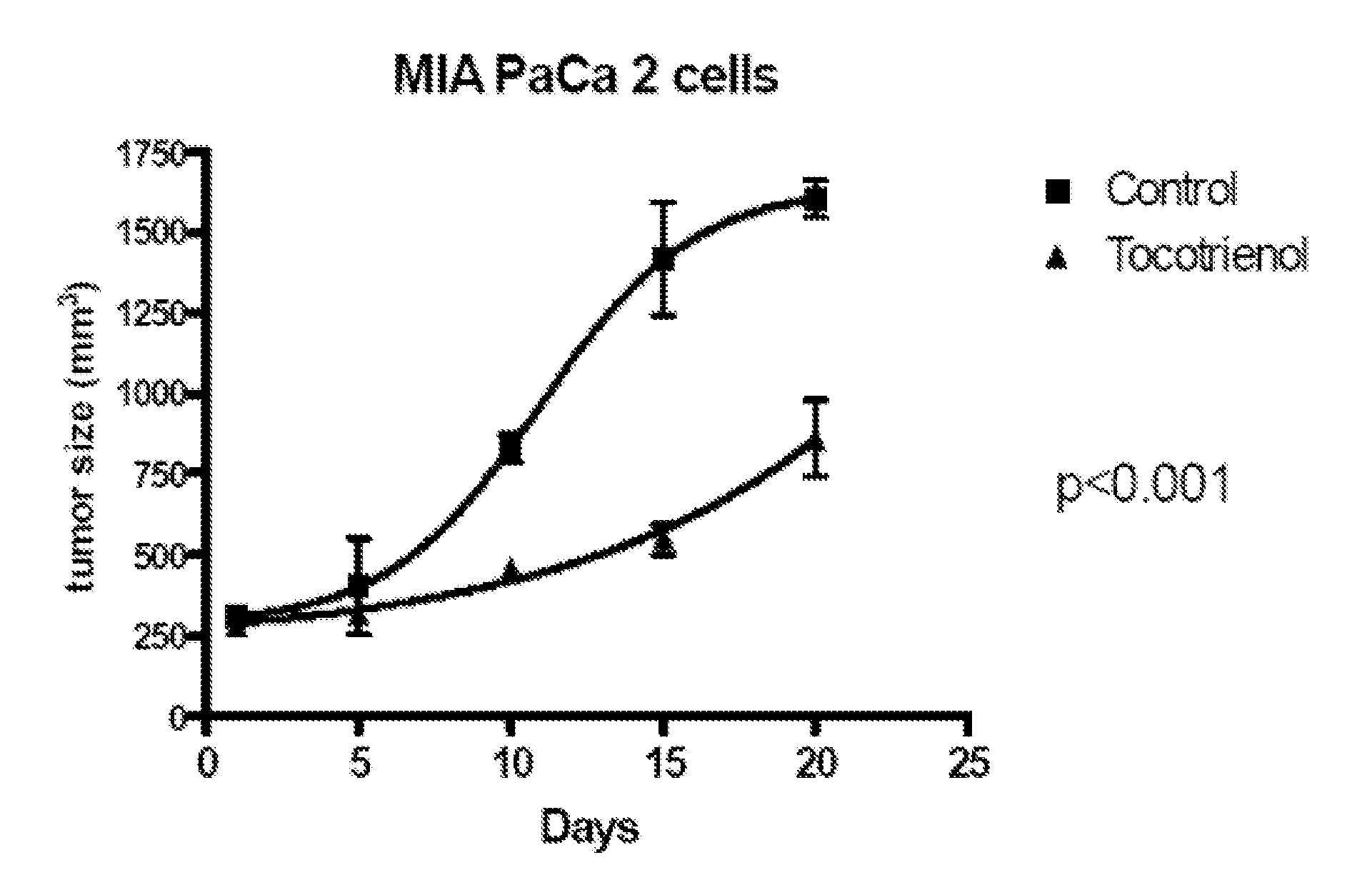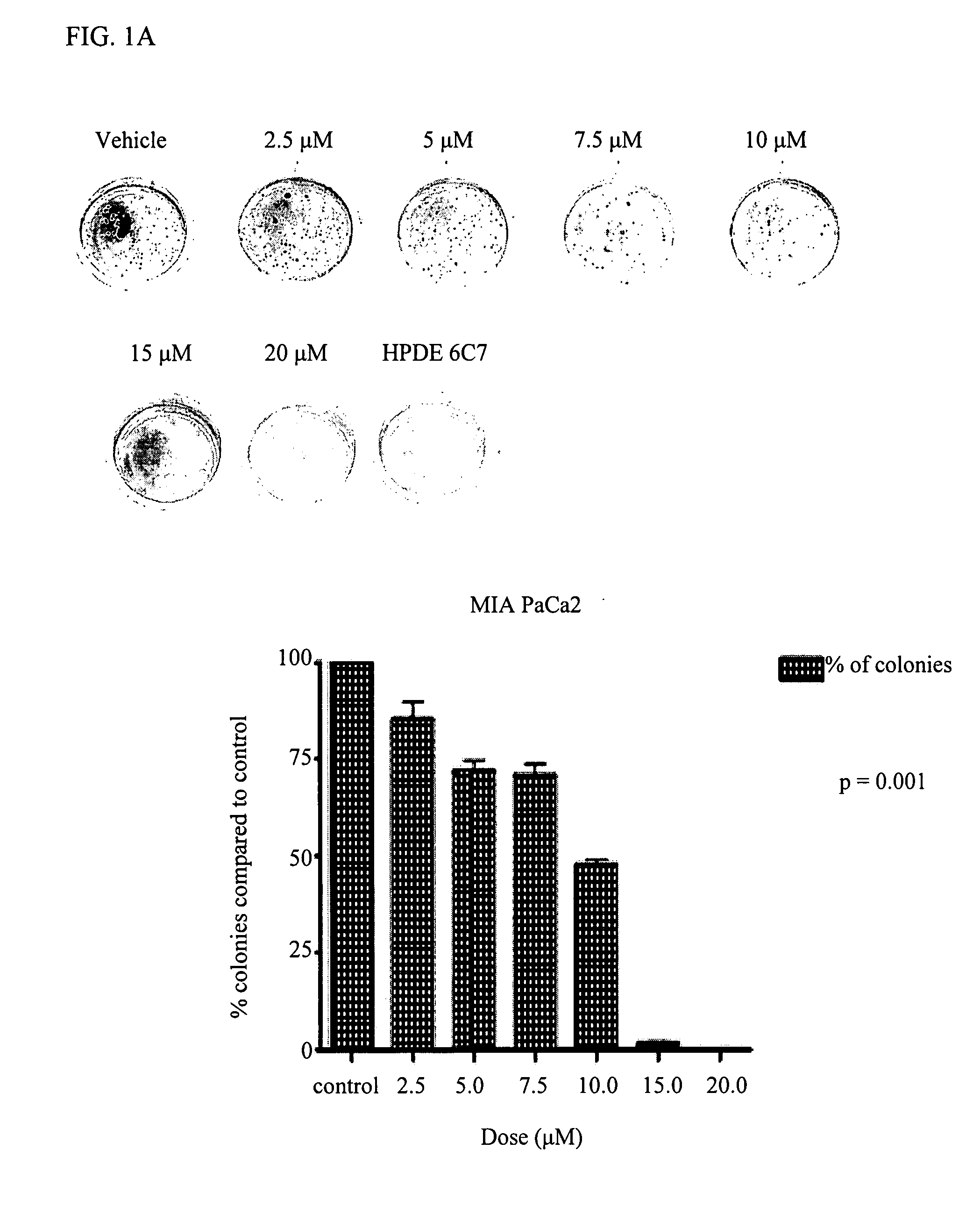Delta-Tocotrienol Treatment and Prevention of Pancreatic Cancer
a technology of delta-tocotrienol and treatment, applied in the direction of drugs, instruments, immunological disorders, etc., can solve the problems of high translocation and deletion rate, high rate of translocation and deletion, and almost uniform death of pancreatic cancer once invasiv
- Summary
- Abstract
- Description
- Claims
- Application Information
AI Technical Summary
Benefits of technology
Problems solved by technology
Method used
Image
Examples
example i
[0086] SW1990 pancreatic cancer cells (Panc-1) were cultured in complete DMEM media containing 10% fetal bovine serum (FBS) and 1% penicillin-streptomycin, and 1% L-glutamine. BxPc-3 pancreatic cancer cells were cultured in complete RPMI media containing 10% fetal bovine serum (FBS), and 1% penicillin-streptomycin, 1% HEPES buffer, 1% sodium pyruvate and 1% L-glutamine. HPDE6-C7 cells were cultured in serum-free keratinocyte SFM media. All cells were maintained at 37° C. in a humidified incubator with 5% CO2.
[0087] Tables I (24 hours), II (48 hours) and III (72 hours) show the associated results. The columns of each table are the different treatments, comprising a single dose (50 μM) as follows: Control (no treatment), Vehicle (vehicle only, maybe a solvent), T3 alpha (alpha tocotrienol), T3 beta (beta tocotrienol), T3 gamma (gamma tocotrienol), T3 delta (delta tocotrienol), T alpha (alpha tocopherol), T beta (beta tocopherol), TS (tocopherol succinate), GG (geranylgeraniol), SA (s...
example ii
[0090] MiaPaCa-2 cells were cultured in complete DMEM media containing 10% fetal bovine serum (FBS) and 1% penicillin-streptomycin, and 1% L-glutamine. BxPc-3 pancreatic cancer cells were cultured in complete RPMI media containing 10% fetal bovine serum (FBS), and 1% penicillin-streptomycin, 1% HEPES buffer, 1% sodium pyruvate and 1% L-glutamine. HPDE6-C7 cells were cultured in serum-free keratinocyte SFM media. All cells were maintained at 37° C. in a humidified incubator with 5% CO2.
[0091] Tables IV (24 hours), V (48 hours) and VI (72 hours) show the associated results. The columns of each table are the different treatments, comprising a single dose (50 μM) as follows: Control (no treatment), Vehicle (vehicle only, maybe a solvent), T3 alpha (alpha tocotrienol), T3 beta (beta tocotrienol), T3 gamma (gamma tocotrienol), T3 delta (delta tocotrienol), T alpha (alpha tocopherol), T beta (beta tocopherol), TS (tocopherol succinate), GG (geranylgeraniol), SA (succinic acid). The number...
example iii
[0094] MiaPaCa-2 cells were cultured in complete DMEM media containing 10% fetal bovine serum (FBS) and 1% penicillin-streptomycin, and 1% L-glutamine. BxPc-3 pancreatic cancer cells were cultured in complete RPMI media containing 10% fetal bovine serum (FBS), and 1% penicillin-streptomycin, 1% HEPES buffer, 1% sodium pyruvate and 1% L-glutamine. HPDE6-C7 cells were cultured in serum-free keratinocyte SFM media. All cells were maintained at 37° C. in a humidified incubator with 5% CO2.
[0095] Table VII (48 hours) and Table VIII (5 Days) show the associated results. The columns of each table are the different treatments, comprising a single dose (50 μM) as follows: Control (no treatment), Vehicle (vehicle only, maybe a solvent), T3 alpha (alpha tocotrienol), T3 beta (beta tocotrienol), T3 gamma (gamma tocotrienol), T3 delta (delta tocotrienol), T alpha (alpha tocopherol), T beta (beta tocopherol), TS (tocopherol succinate), GG (geranylgeraniol), SA (succinic acid). Each column repres...
PUM
| Property | Measurement | Unit |
|---|---|---|
| volume | aaaaa | aaaaa |
| morphology | aaaaa | aaaaa |
| antioxidant effect | aaaaa | aaaaa |
Abstract
Description
Claims
Application Information
 Login to View More
Login to View More - R&D
- Intellectual Property
- Life Sciences
- Materials
- Tech Scout
- Unparalleled Data Quality
- Higher Quality Content
- 60% Fewer Hallucinations
Browse by: Latest US Patents, China's latest patents, Technical Efficacy Thesaurus, Application Domain, Technology Topic, Popular Technical Reports.
© 2025 PatSnap. All rights reserved.Legal|Privacy policy|Modern Slavery Act Transparency Statement|Sitemap|About US| Contact US: help@patsnap.com



